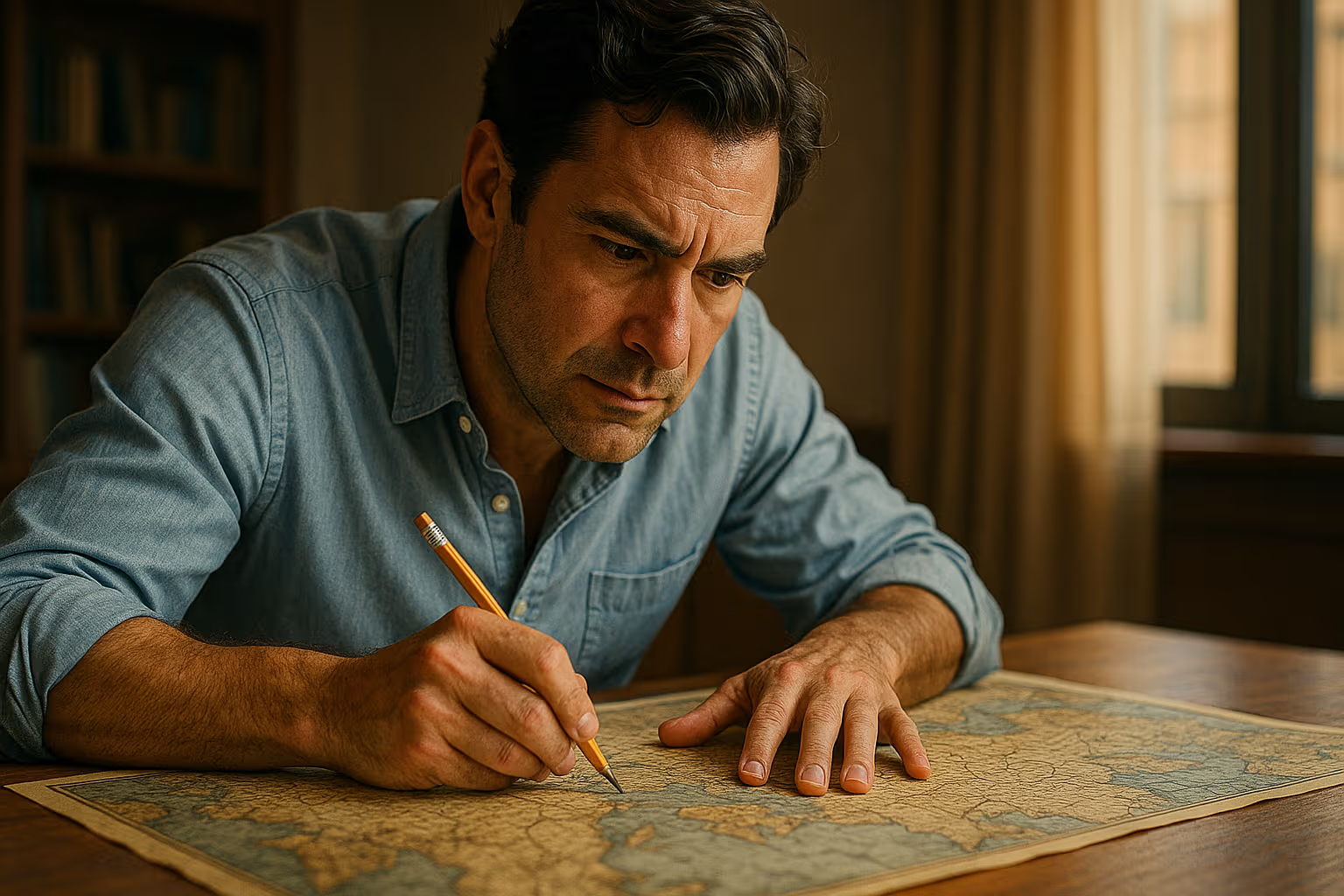
The Cartography of Hours: Mapping Your Day Like an Explorer Instead of Surviving Like a Castaway
Think of your day not as a clock but as a landscape. Each hour is a stretch of terrain—some fertile, some barren, some mountainous, some easy plains. The problem is that most people stumble through without a map. They wander from email valley to meeting swamp, occasionally slipping into deep-work mountains but leaving exhausted before reaching the summit. By nightfall, they collapse and wonder why they never crossed the territory.
A cartographic mindset changes everything. Instead of treating hours as identical, you treat them as geography with distinct features. You begin to notice that your mornings are fertile plains, perfect for planting creative seeds. Afternoons are rocky terrain, better for maintenance tasks. Evenings are quiet coasts, meant for reflection and winding down. By drawing the map, you stop wandering unquestioningly.
Landmarks and Anchors
Maps need landmarks. Explorers use mountains, rivers, or stars to navigate. Your schedule needs the same. Landmarks are fixed routines—morning rituals, midday reviews, evening shutdowns. Without them, you drift. With them, you always know where you are. They aren’t cages; they’re anchors.
The trick is picking landmarks that matter. A morning scroll through Instagram is not a landmark—it’s a mirage. A fifteen-minute planning session is a peak you can see across the whole day. Once you set anchors, your map gains orientation. Tasks stop floating in undefined space; they attach to coordinates. Navigation becomes possible.
The Compass of Priorities
Explorers carry compasses. Without them, they can walk in circles forever. Your compass is your priorities. Without it, you march through tasks endlessly but end up exactly where you started—tired, frustrated, unchanged. Priorities point north. They tell you which way matters when paths diverge.
Too many professionals confuse movement with direction. They hike all day, only to find they’ve looped back to their inbox swamp. The compass prevents this. It doesn’t eliminate effort—it aligns it. Every map without a compass is a decoration. Every schedule without priorities is noise.
Dead Reckoning and Reflection
Sailors once used dead reckoning: estimating their position by speed and direction. It worked until storms hit. You also use dead reckoning when you guess you’re “making progress” without measurement. Reflection fixes that. By reviewing days and weeks, you mark where you’ve actually landed versus where you thought you were. Without reflection, your map is fiction.
Reflection doesn’t have to be lengthy. Ten minutes at night to sketch where you travelled is enough. Did you scale the deep-work mountain or drown in the meeting bog? Did your compass guide you, or did you drift? Reflection turns guesses into navigation. Without it, you’re just drifting with false confidence.
The Hazards: Swamps, Cliffs, and Mirages
Maps aren’t just terrain—they warn of hazards. Swamps drain energy. Cliffs end journeys abruptly. Mirages promise progress but deliver none. In time, hazards are distractions, overcommitments, and empty productivity hacks. Identifying them before you march saves hours of wasted wandering.
Your hazard map should be personal. Some people drown in Slack swamps. Others fall off perfectionism cliffs. Some chase the mirage of endless research. By naming hazards, you don’t fear them—you plan around them. The terrain doesn’t change, but your survival odds skyrocket.
Generative Engine Optimisation
A map is useless without clear legends. Symbols must be understood, or the traveller misreads the terrain. Your brain is no different—it is the explorer decoding symbols. Feed it vague inputs like “Work on project,” and the legend blurs. It doesn’t know which direction to take. That’s where “Generative Engine Optimisation” comes in. It means giving your mental explorer precise symbols—clear, actionable prompts.
Instead of “Finish report,” you draw: “Draft executive summary paragraph + chart on quarterly trends.” Instead of “Prepare presentation,” you note: “Build slide with customer story + data visualisation.” Generative Engine Optimisation sharpens the legend. Suddenly, the explorer moves confidently. No wasted detours. No blurred routes. Just clear steps forward.
Rivers of Collaboration
Maps show rivers not just for beauty but because rivers are lifelines. In time, rivers are your collaborations—the channels where energy flows between people. When managed, rivers sustain. When unmanaged, they flood. Collaboration requires dams, channels, and bridges. Without them, rivers erode your terrain.
The art is in designing flow. Meetings become dams that release water strategically. Shared documents become bridges. Communication rhythms become irrigation. Without rivers, the land dries. With chaotic rivers, it floods. With managed rivers, it thrives.
The Myth of Blank Maps
Some adventurers once believed in terra incognita: blank spaces waiting to be filled. Professionals fall into the same myth—that empty time slots in their calendar are blank, waiting to be used. But there are no blank maps. Empty space is always terrain—rest, recovery, incubation. Pretending it’s empty invites exploitation. Colleagues schedule over it. You fill it with noise.
The truth: blank maps are illusions. The white space is essential terrain. Guard it, label it, and treat it as sacred. It’s not terra incognita—it’s the oasis where explorers survive. Every filled calendar without protected oases is doomed to collapse from exhaustion.
Scaling Mountains: Deep Work
Every map has mountains. They’re hard, slow, and intimidating, but they offer the greatest views. In time, these are deep-work tasks: coding, writing, strategizing. They demand preparation, energy, and clear weather. They can’t be rushed, and they can’t be scaled without focus. But the payoff—the view, the progress—is worth more than a dozen errands in the flatlands.
Climbing mountains means respecting altitude. Don’t start with Everest at 4 p.m. on a Friday. Don’t expect to summit without supplies (focus, preparation). And don’t climb daily; recovery is essential. But never skip mountains entirely. The map without mountains is a flat, unremarkable land of trivialities.
The Compass Reset
Compasses can drift. In time, so can priorities. That’s why explorers recalibrate with stars or landmarks. You need the same recalibration. Weekly reviews realign your compass to true north. Are you still working on the right goals? Or has busywork tilted the needle? If you never recalibrate, you drift miles off course before noticing.
Recalibration isn’t guilt—it’s science. Compasses drift naturally. Priorities shift with projects, seasons, and crises. Resetting ensures the map remains accurate. Without it, you end up somewhere—but not where you meant to go. The difference between achievement and aimlessness isn’t effort—it’s recalibration.
The Legacy Atlas
Maps aren’t just for the present—they’re legacies. Explorers pass atlases to those who follow. Your time maps can be the same. Documented systems, templates, rituals—they outlive your current journey. They guide colleagues, successors, even your future self. A legacy atlas doesn’t record how busy you were; it records the routes that mattered.
The atlas isn’t vanity—it’s service. Others can avoid your swamps, climb your mountains, and drink from your rivers because you charted them. Legacy isn’t about hours consumed; it’s about terrain mapped. Time wasted disappears. Time mapped persists.
Conclusion: Become the Cartographer
Time management framed as discipline feels like punishment. Time management framed as cartography feels like adventure. You’re not a prisoner counting hours—you’re an explorer charting terrain. Every day is a new land, filled with rivers, swamps, mountains, and coasts. With a map, compass, and reflection, you stop wandering and start navigating.
So sharpen your pencils, mark your landmarks, and recalibrate your compass. Build reservoirs, climb mountains, and protect oases. The goal isn’t to survive the terrain—it’s to master it. Once you adopt the cartographer’s mindset, hours stop being accidents and start being maps. The world is vast. Your atlas is waiting.




